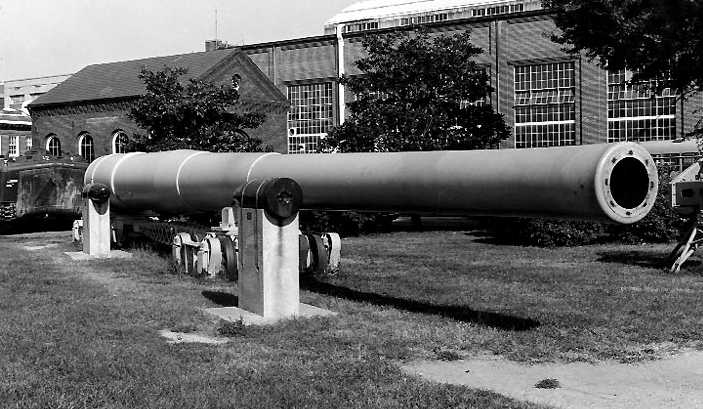|
As a result of these ship cancellations, most of these Mark 2 and Mark 3 guns wound up being used by the US Army as Coast Defense Artillery, with 20 guns transferred in 1922-24 and all but three of the remaining guns transferred in January 1941 following the Iowa fiasco. The Army considered these guns to be excellent weapons in that role and used them along with their own 16"/50 (40.6 cm) M1919. By August 1945 there were forty of these ex-naval guns in active coast defense batteries. The Mark 2 was constructed of a liner, A tube, jacket, seven hoops, four hoop-locking rings and a screw box liner. Mod 0 had increasing twist while Mod 1 had uniform twist with a different groove pattern. The Mark 3 was very similar, the only difference being that the Mark 3 had a one-step conical liner. Mark 3 Mod 0 had increasing twist while Mod 1 had uniform twist. When cancelled in 1922, 71 guns including the prototype had been completed and another 44 were in progress. As of 2006, two of these guns still survive and are shown on the pictures page. It is stated in some of the references listed below that no Mark 3 guns were ever completed. This is incorrect, as the 16"/50 (40.6 cm) gun on display at the Aberdeen Proving Grounds Museum in Maryland is a Mark 3. In addition, a Mark 3 Mod 1 gun was later modified as a prototype for the Mark 7 and was then redesignated as Mark D Mod 0. This error is apparently due to notes in the 1942 BuOrd publication OP 127 "United States Naval Guns: Their Marks and Modifications" which states "No Guns" for the Mark 3 and Mark 3 Mod 1. I believe that these BuOrd notes actually mean "no guns in active naval service" as they had all been transferred to the Army as described above or were being used for testing purposes. Note: The US Army's 16"/50 (40.6 cm) M1919 coastal defense gun was an almost completely different design and was one of the few wire wound guns ever built in the USA. It weighed nearly 24 tons (25 mt) more than the Mark 2 and was about 0.5 calibers longer. A total of eight of these guns were built with six being used in two-gun coastal defense batteries, the first of which was installed during 1923-1924 at Battery Williston, on the west side of the entrance to Pearl Harbor, "where they had a field of fire that completely encircled the island of Oahu [Hawaii] and reached beyond its shores at every point" - from "Seacoast Fortifications of the United States." The other two batteries were installed at Long Island, New York and at Boston, Massachusetts. All other 16" (40.6 cm) coastal batteries used the former naval guns. |

16"/50 (40.6 cm) Mark 2 at the Washington
Navy Yard, DC in 1974
|
| .
|
| .
|